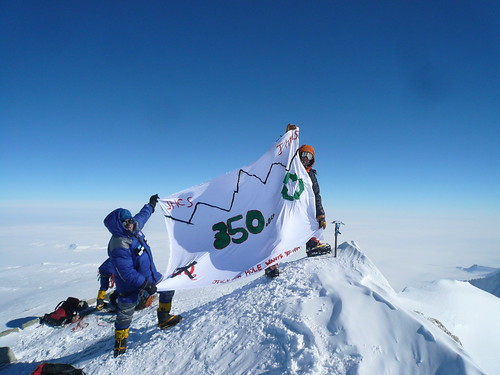350: Climate activists begin day of action
Posted by Big Gav in 350, global warming
The SMh has a report on today's global warming "day of action" organised by 350.org (whose server seems to be melting down under the strain today) - Climate activists begin day of action.
Climate change activists have begun staging events at iconic Sydney locations as part of an international day of climate action.
Thousands of events will be held in 141 countries worldwide in an bid to reduce the amount of carbon in the atmosphere to a level of 350 parts per million.
Synchronised swimmers held up "350" placards at Bronte Baths early in the morning, while Bondi Beach swimmers used their bodies to state the figure on the sand as part of 50 events to be held throughout NSW on Saturday.
The bells of St Mary's Cathedral in the city will toll 350 times in honour of the day, while the flagship event at Sydney Opera House will see attendees spell out a giant 350 on the Opera House steps at 2pm (AEDT).
The event, which will kick off the worldwide campaign, will be accompanied by a tall ship cruise and live music from the Cat Empire, the Beautiful Girls and Felix Riebl.
TreeHugger has some background from Bill McKibben - The Science of 350, the Most Important Number on the Planet.
350 is the most important number on the planet.
Which is odd, because until about 22 months ago no one even knew it mattered.
But that's when, in December of 2007, NASA's Jim Hansen gave a slide show at the American Geophysical Union annual meeting in San Francisco. He'd been thinking about what it meant that we'd just come through a summer of very rapid ice melt in the high Arctic, and that researchers were reporting "ahead of schedule" changes in dozen other of the earth's big physical features--melting glaciers, acidifying oceans and so on.
Combined with reams of paleo-climate data, his team believed they now had enough information to finally draw a red line for the planet: when atmospheric concentrations of carbon dioxide were above 350 ppm, they said, global warming would be dangerously out of control. In fact, they said in the abstract of the paper they soon published, above 350 you couldn't have a planet "similar to the one on which civilization developed and to which life on earth is adapted."
It's as if we suddenly discovered what normal body temperature was, so we'd be able to tell when we were running a fever. In that sense, it came as a great relief.
But in every other sense, it was a pretty devastating number. For one thing, we're already past it, at 390 ppm and rising two ppm annually--that's why the Arctic is melting. For another thing, it means the work nations and individuals must do to reduce their carbon footprints is much larger, and must happen much more swiftly, than we'd believed. Hansen's data shows that as a planet we'd need to get off coal by 2030 in order for the planet's forests and oceans ever to bring atmospheric levels back down below 350--that's the toughest economic and political challenge the earth has ever faced.
But it's not as if we have a choice. The most useful thing about having a number is that it forces us to grow up, to realize that the negotiations that will happen later this fall in Copenhagen aren't really about what we want to do, or what the Chinese want to do, or what Exxon Mobil wants to do. They're about what physics and chemistry want to do: the physical world has set its bottom line at 350, and it's not likely to budge.
Ausculture has a look at Australia's participation rate in the festivities - Who’s getting involved in International Day of Climate Action?.
There are currently 4,800 actions lodged on their website globally, from 179 countries, of which our 201 make up the 4.2%. (Of course in theory 1 event could involve anywhere from one person to a country’s entire population, but it’s a fair guide.)
Nearly half of Australia’s events are taking place outside capital cities, but focussing on the capitals does enable me to compare participation around the country – the more events per hundred thousand people the higher the participation.
350Participation.gif
Hobart comes out on top, with Darwin a close second. Melbourne, Sydney and Canberra are all similar, at about half the participation. Brisbane is slightly below the previous three. Adelaide and Perth have less than a quarter of Hobart’s events per capita. Adelaide is the biggest surprise here – no resources boom to distract them and some fierce environmental impacts recently.
Then again, Adelaide doesn’t have The Age or The Sydney Morning Herald. The big surprise for Brisbane is that The Courier-Mail – a News Ltd. paper – has an environmentalist on the staff! And I’m not talking one of those woolly “lets protect the Great Barrier Reef because it’s good for tourism” types, I’m talking “you might want to think twice before chaining yourself to a coal conveyor belt because having a criminal record is no fun”. Graham Readfearn, ausculture salutes you!









